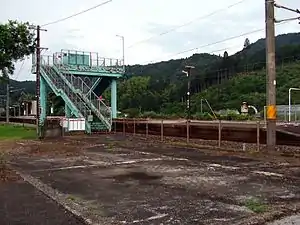Naomi Station
Naomi Station (直見駅, Naomi-eki) is a railway station on the Nippō Main Line operated by JR Kyushu in Saiki, Ōita, Japan.[1][2]
Naomi Station 直見駅 | |
|---|---|
 Naomi Station in 2009 | |
| Location | Japan |
| Coordinates | 32°55′42″N 131°48′28″E |
| Operated by | |
| Line(s) | ■ Nippō Main Line |
| Distance | 208.8 km from Kokura |
| Platforms | 1 island platform |
| Tracks | 2 + 1 siding |
| Construction | |
| Structure type | Low embankment |
| Disabled access | No - platform accessed by footbridge |
| Other information | |
| Status | Unstaffed |
| Website | Official website |
| History | |
| Opened | 20 November 1920 |
| Passengers | |
| FY2015 | 4 daily |
| Location | |
 Naomi Station Location within Japan | |
Lines
The station is served by the Nippō Main Line and is located 208.8 km from the starting point of the line at Kokura.[3]
Layout
The station, which is unstaffed, consists of an island platform serving two tracks, with a siding. There is no station building. A short flight of steps leads up from the access road to a small forecourt from where a footbridge gives access to the island platform which has a shelter for waiting passengers.[2][3]
 A view of the station platform looking north. The siding can be seen branching to the left.
A view of the station platform looking north. The siding can be seen branching to the left. A view of the station platform looking south.
A view of the station platform looking south.
History
The private Kyushu Railway had, by 1909, through acquisition and its own expansion, established a track from Kokura to Yanagigaura. The Kyushu Railway was nationalised on 1 July 1907. Japanese Government Railways (JGR), designated the track as the Hōshū Main Line on 12 October 1909 and expanded it southwards in phases, with Gōnohara (today Naokawa) opening as the new southern terminus on 20 November 1920. On the same day, Naomi was opened as an intermediate station on the new track. On 15 December 1923, the Hōshū Main Line was renamed the Nippō Main Line. With the privatization of Japanese National Railways (JNR), the successor of JGR, on 1 April 1987, the station came under the control of JR Kyushu.[4][5]
Passenger statistics
In fiscal 2015, there were a total of 1,628 boarding passengers, giving a daily average of 4 passengers.[6]
See also
References
- "JR Kyushu Route Map" (PDF). JR Kyushu. Retrieved 23 February 2018.
- "直見" [Naomi]. hacchi-no-he.net. Retrieved 5 May 2018.
- Kawashima, Ryōzō (2013). 図説: 日本の鉄道 四国・九州ライン 全線・全駅・全配線・第6巻 熊本 大分 エリア [Japan Railways Illustrated. Shikoku and Kyushu. All lines, all stations, all track layouts. Volume 6 Kumamoto Ōita Area] (in Japanese). Kodansha. pp. 48, 83. ISBN 9784062951654.
- Ishino, Tetsu; et al., eds. (1998). 停車場変遷大事典 国鉄・JR編 [Station Transition Directory - JNR/JR] (in Japanese). I. Tokyo: JTB Corporation. pp. 228–9. ISBN 4533029809.
- Ishino, Tetsu; et al., eds. (1998). 停車場変遷大事典 国鉄・JR編 [Station Transition Directory - JNR/JR] (in Japanese). II. Tokyo: JTB Corporation. p. 756. ISBN 4533029809.
- "平成28年版 大分県統計年鑑 11 運輸および通信" [Oita Prefecture Statistics Yearbook 2016 Edition Section 11 Transportation and Communications]. Oita Prefectural Government website. Retrieved 8 April 2018. See table 128 Transport situation by individual railway stations (JR Kyushu JR Freight).